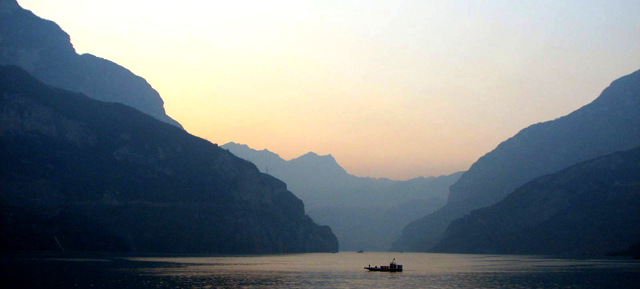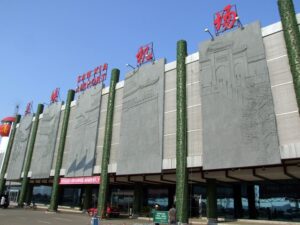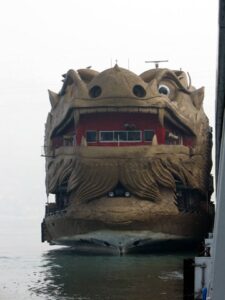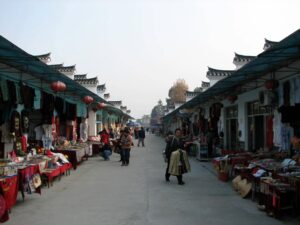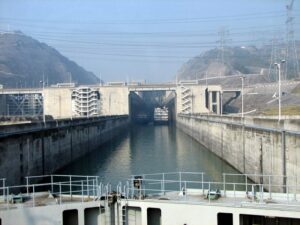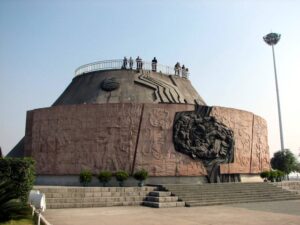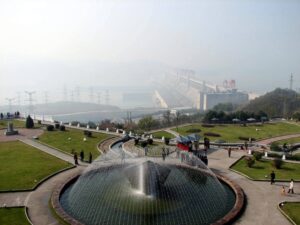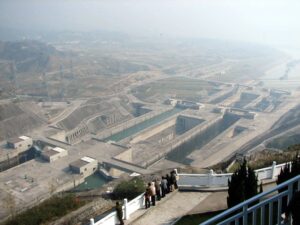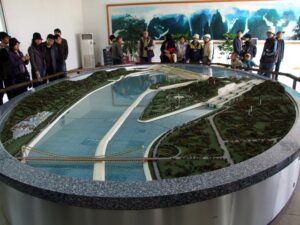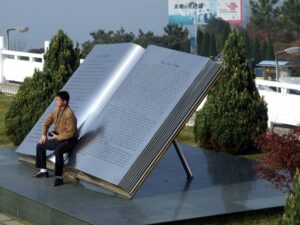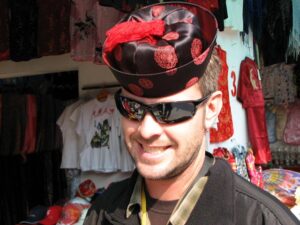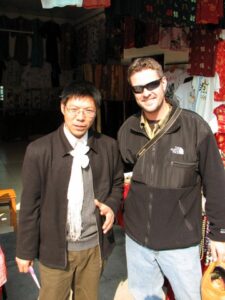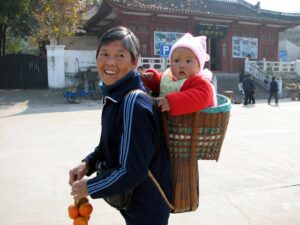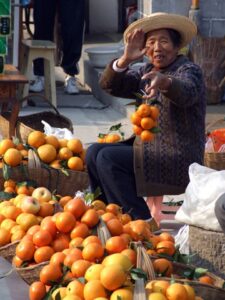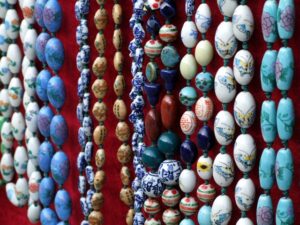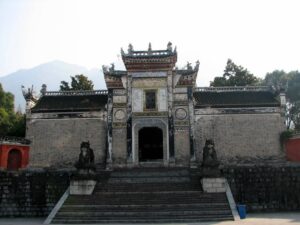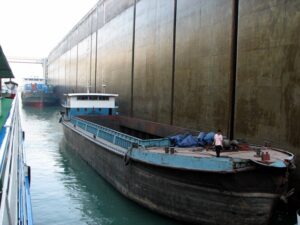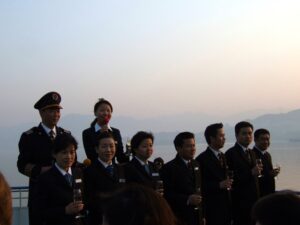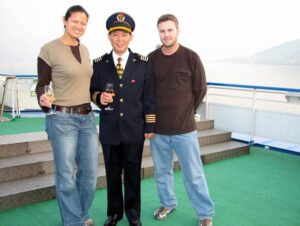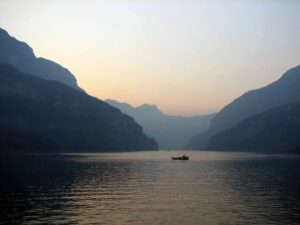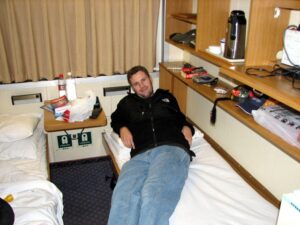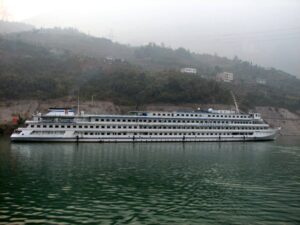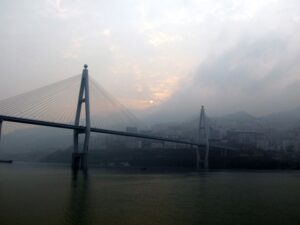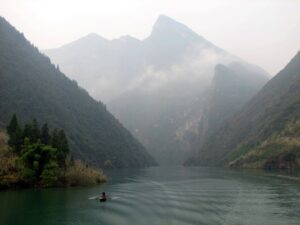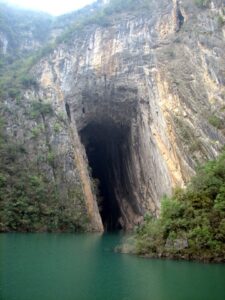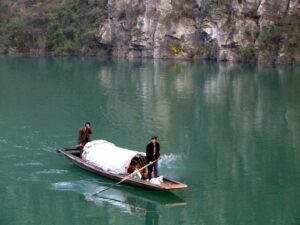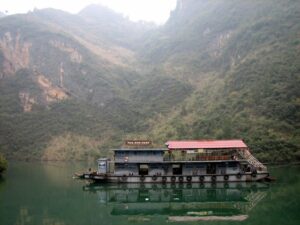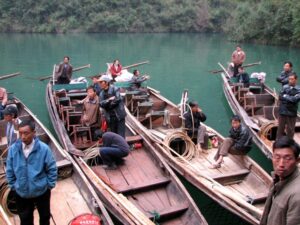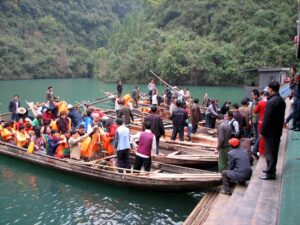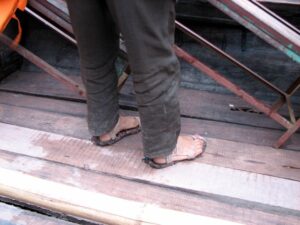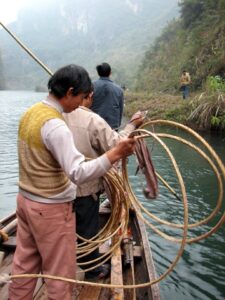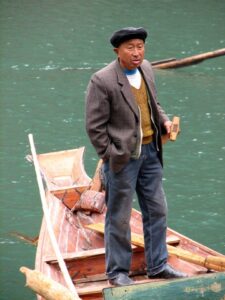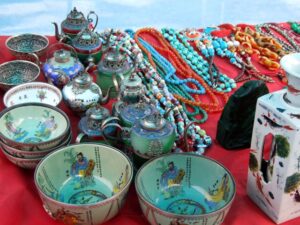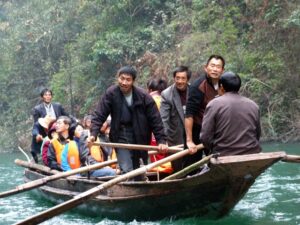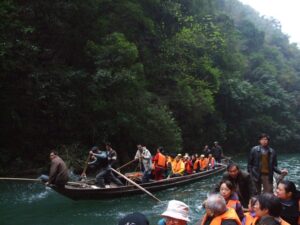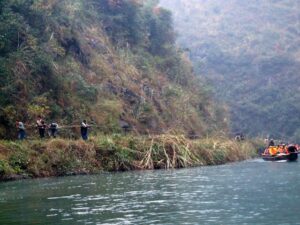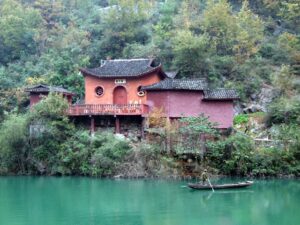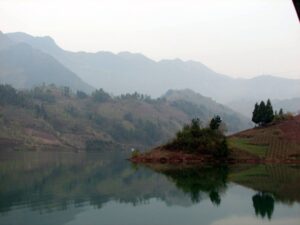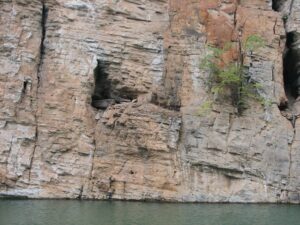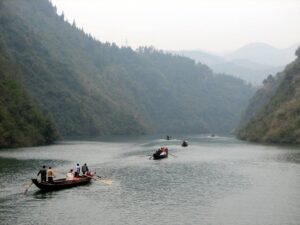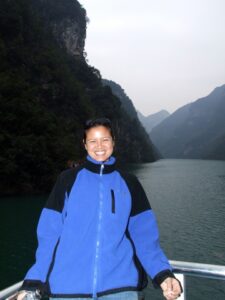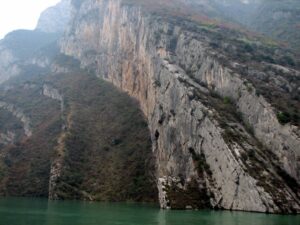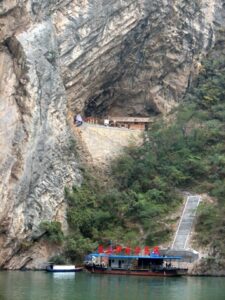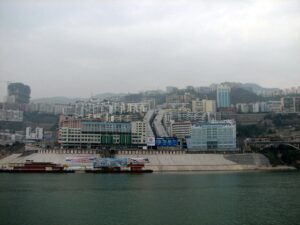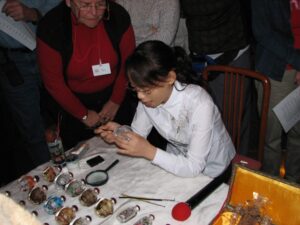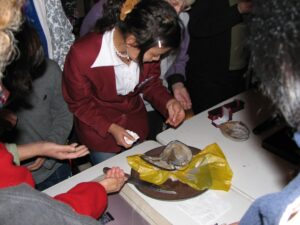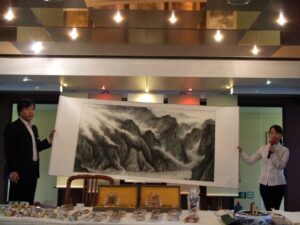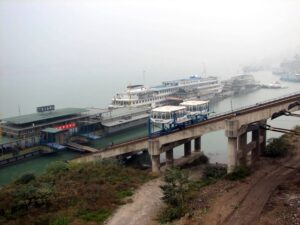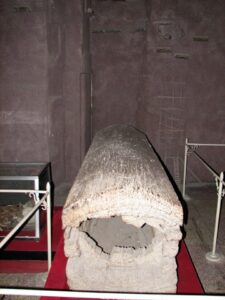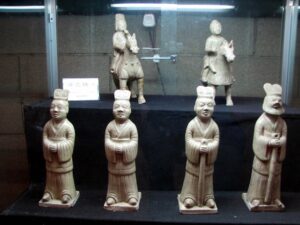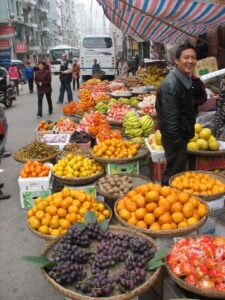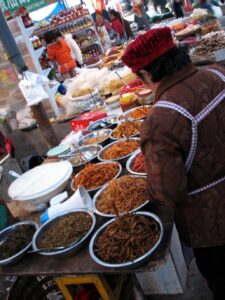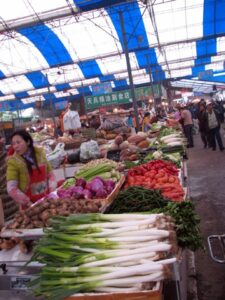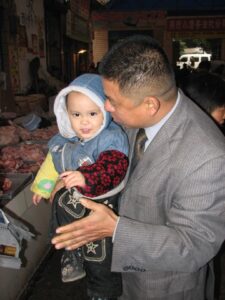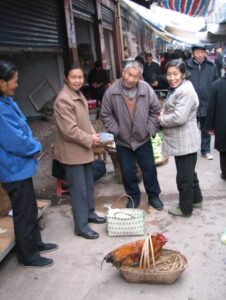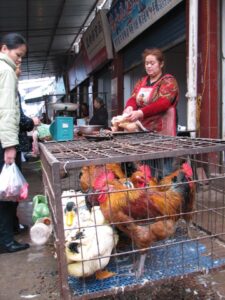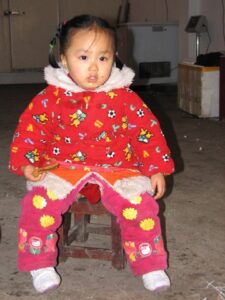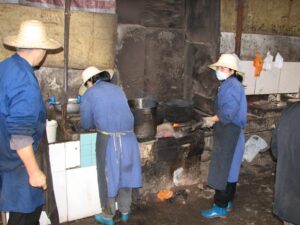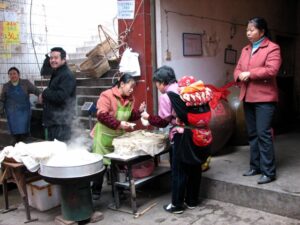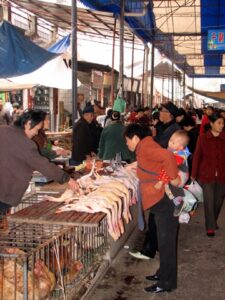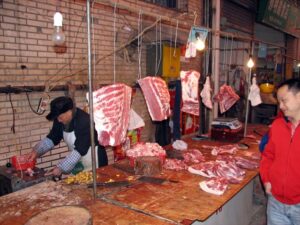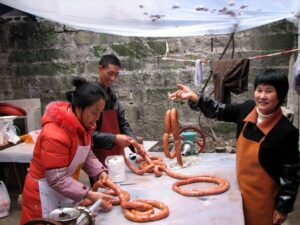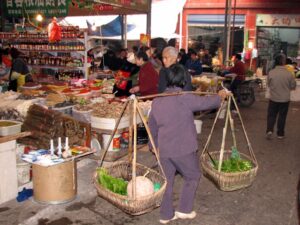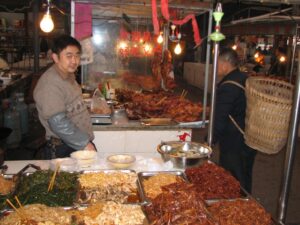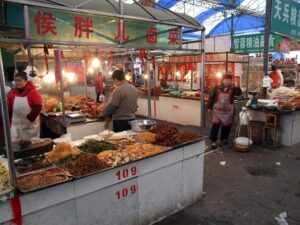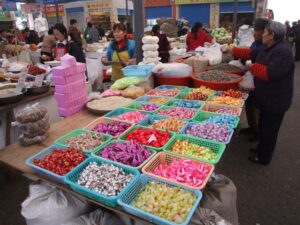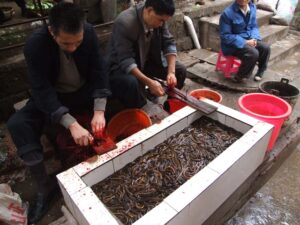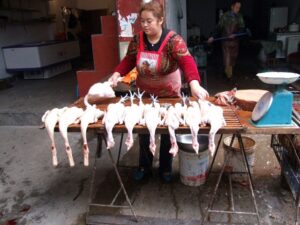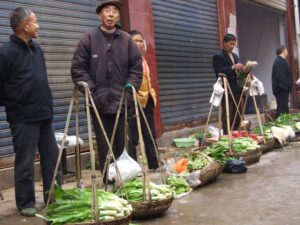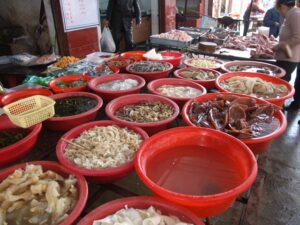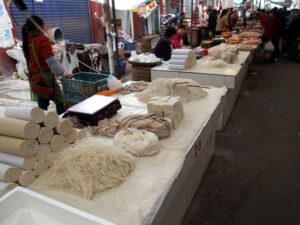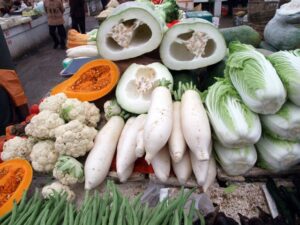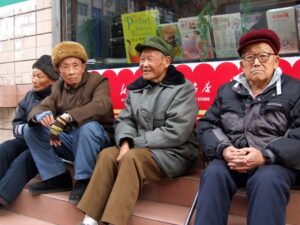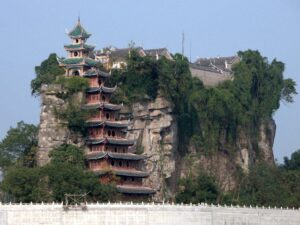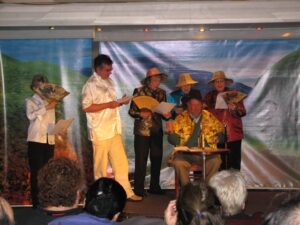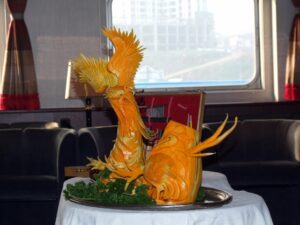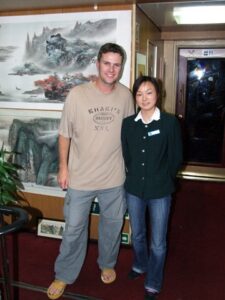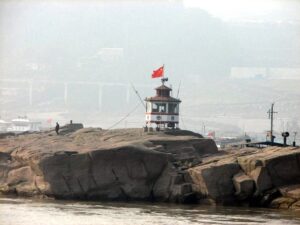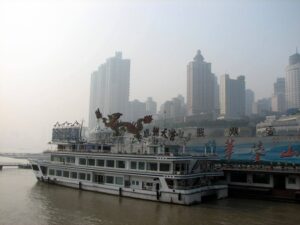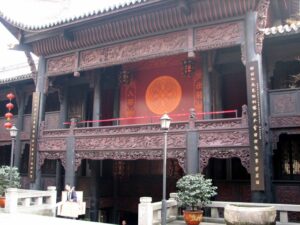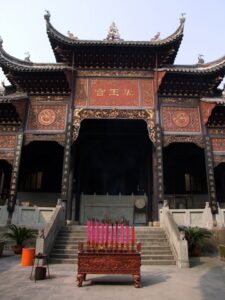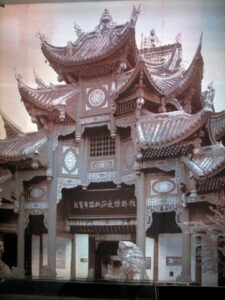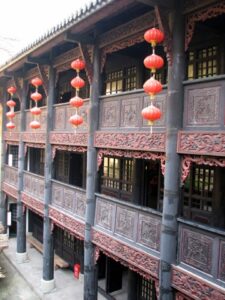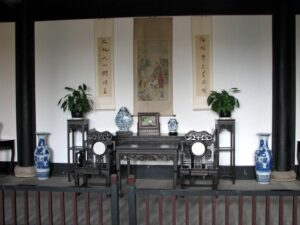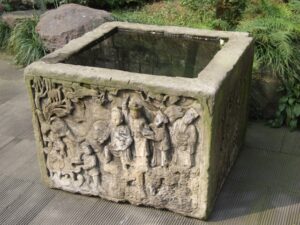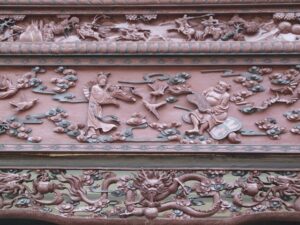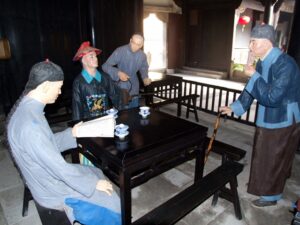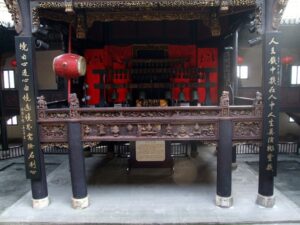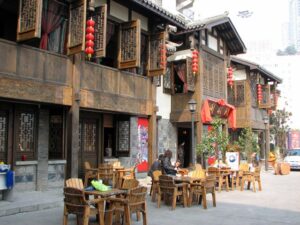This section of our China trip gave us a brief introduction to the Three Gorges Dam (a controversial hydroelectric project that displaced over 1.9 million people in the attempt to become the world’s largest dam), Shennong Stream (a 60 kilometer tributary off the Yangtze River that is home to various Minority groups and is most famous for its picturesque scenery, deep gorges, thick vegetation and hanging coffins), Wanxian City (a vibrant market scene overwhelmed our senses), Shibaozhai (a 12 story, Qing Dynasty, redwood fortress built against a rectangular rock with sheer cliffs towards the riverbank), and lastly, Chongqing (the largest industrial and commercial city in southwest China that is home to 30 million people).
24 Nov 07: Our guide, Guo Wei, was standing by awaiting our arrival. Once we touched down in Yichang, he wasted no time getting us loaded into our van. The drive from the airport to downtown Yichang took just under an hour, with Guo Wei explaining that he considered this portion of China to be a great place to live in because of its excellent air quality, low costs of living, and minimal vehicular traffic on the roads. In fact, he proudly explained that Yichang was extremely popular with retirees, as they got more bang for their buck here, in relative seclusion. Guo Wei also gave us a brief lecture on the Three Gorges Dam (approval granted in 1992 and construction started in 1994). Once we arrived into Yichang, Guo Wei took us directly to the Yichang museum, where we linked up with a guide named Rebecca for an excellent overview of the history of the dam and the surrounding area. Afterwards, we stopped by the antique parlor where select museum pieces were for sale. We saw an old red jade incense burner that was gorgeous, and debated briefly if we wanted to buy it. Since we couldn’t make up our minds on the spot, we decided to go to our hotel to check in first. The Taohualing Hotel is showing its age…it’s an OK hotel but we weren’t prepared for the smoke fumes that permeated from our room. As non smokers, the smoke smell was quite strong and disturbing. What is the deal with smokers in China? We didn’t realize what a problem this was beforehand, but quickly came to realize if you desire a smoke-free atmosphere, do not visit China! Smokers blow cheap, overwhelming fumes in all directions, and it gets old fast. We were hungry and decided to have dinner, but not before paying the museum shop one last visit. And of course we ended up buying the incense burner…it was a cool souvenir even if it probably wasn’t real jade. J We did learn that most of the funds raised would go towards the renovations for the new Yichang museum, and we got a certificate of authenticity that granted permission to export the antique out of the country.
Dinner was at a really nice, local hotel where a vast buffet was laid out. We ate freshly grilled beef, roasted sparrow (I know, sounds different and it was!), bacon rolls, duck, shrimp, pumpkin soup, rice wrapped in seaweed (kimbap), sushi, chicken…the works. Dinner was great and true to form, both of us overate and left feeling stuffed. You’d think we were getting tired of Chinese food by now, but of course not! The food never seemed to get old, and there was so much variety to be had every day. Guo Wei dropped us off at the hotel with an early morning pickup tomorrow to take us to meet our Yangtze River Cruise.
25 Nov 07 – Yichang – Badong (Yangtze River Cruise Day 1): The breakfast room of the Taohualing Hotel was decorated in a frilly pink, wedding banquet theme. We later found out from Guo Wei that this hotel is often booked for wedding banquets…so much so that the hotel just keeps the “breakfast” room ready for a wedding ceremony at any given moment. After breakfast, we checked out of the hotel and linked up with Wei and our driver in the lobby. We had a one hour drive to the three gorges dam project, and stopped by a grocery store enroute to stock up on beer and water (beer is overpriced on the cruise so Wei advised us to bring our own supply). As long as we didn’t stockpile loads of beer, the cruise director would “look the other way”.
We boarded the Princess Jeannie as Wei thought this was our Yangtze River cruise vessel. However, upon check in we quickly realized that our cruise hadn’t pulled into dock yet. We were to board the Princess Elaine (a sister ship on the China Regal Cruise entourage), which was due within the next few minutes. Once Elaine pulled alongside its sister ship, we weren’t ready for the mad onslaught of passengers ready to disembark. We later found out that our fellow passengers has been “trapped” on the cruise for over 2 days, and this was their first chance to get off the ship. No wonder they were ready to disembark! In the meantime, we still had to get on the cruise, drop off our luggage, and join everyone else for a shore excursion to the 3 gorges dam site. After dropping off our luggage at the reception (we were told we’d collect our room key after the excursion), we linked up with the “individuals” tour group. Our bus had to go through a rather lame “security” inspection, where we were instructed to offload from the bus, walk through a metal detector and present our bags for a cursory glance. What is weird is that if the alarm sounded on the metal detector, it was no big deal, with the security guard waving us through anyway…what is the point of an inspection if it’s not taken seriously? We were told it was necessary in case any terrorists tried to blow up the dam, but there is no way that inspection center would deter any would be attackers!
Our guide was a cheeky Chinese man who kept saying “I’m your damn tour guide”, stressing on “dam”. With his strong accent, we had a hard time understanding him, and eventually just broke free from our group to check out the 3 Gorges Dam on our own. We learned that the 3 Gorges Dam is a hydroelectric river dam that spans the Yangtze River in Yichang. Eventually, the total electrical capacity of the dam will be 22,500 megawatts, which will be the world’s largest hydro-electric power station upon completion. The most interesting portion of this morning’s tour for us was the 5 ship locks that were barely visible from our hilly lookout point. The concept was really cool. The ship locks acted like an “elevator”, with water levels rising from a total of 200 meters (600 feet) between all 5 ship locks. Since one lock wouldn’t be able to support such a dramatic rise in the water level, there are a total of 5 locks (with only 4 currently in use but a spare for future growth), and the passage through the locks takes approximately 3 hours. The best place to get a bird’s eye view of the entire project is up at the museum center, where a miniature scale model lays out the entire project in 360 degree detail.
After examining the 3 Gorges Dam site to our hearts content, we met back up on the bus and got dropped off back at the cruise. We decided to do some shopping, where we quickly learned it pays to bargain hard. Prices started to plummet after we feigned no interest, and we were able to get some nice souvenirs at reasonable prices. There were several older ladies with babies in baskets strapped to their backs hawking oranges, and of course the “baby in a basket” caught our eye. We ended up getting some oranges that lasted as snacks for us for the duration of the cruise. We actually really enjoyed the impromptu shopping opportunities as it gave us a chance to bargain directly with locals. Becky’s mandarin dramatically improved as she started to remember how to bargain in Chinese! After checking into our cabin 409 on the cruise, we headed down to the 3rd deck for lunch. We didn’t realize it at first, but each table had “assigned” seating, and we were next to cabins 411 and 412. At lunch, we met the ever friendly Greek-Australian trio, who made us jealous when we heard they were on a 5 month odyssey around the world! How awesome was that? They told us about being virtual prisoners on the cruise for the past 2 days, so we completely understood about the mad exodus of passengers this morning while we were attempting to board.
Passing through the ship locks was next on our agenda today, and excitement gathered as the locks filled with water and our cruise was elevated from lock to lock. Altogether, it took about three hours to enter the Xiling Gorge, the first of the 3 gorges. Everyone was thrilled at the spectacular views once we entered into our first gorge, and photos were eagerly snapped away as the sun began to set. We finally met someone of our own age group right before sunset. Francis hailed from California, and was on holiday with his parents on a large tour group. He had Becky’s camera (Canon S2 IS) and we laughed about being the “youngsters” on board the cruise. Francis’ father had been on a Yangtze River cruise years before, and it was interesting to hear how much the riverbank had changed since his last visit. At around 5 pm, we joined our fellow passengers on the top deck for the Captain’s welcome, accompanied by champagne and snacks. Once the sun set, the temperature on deck plummeted, so we sought refuge from the cold indoors. Dinner was filling and we laughed about having a tough life…cruise, eat, sleep, hang out on deck, drink some alcohol and eat some more.
After dinner, Robby headed up to the 5th floor Jade Ballroom for a fashion show. The real excitement was post fashion show, where an end of season auction blowout occurred. The first item up for bid was a black silk jacket that would normally sell for about $50. It sold for $1. This caught everyone’s attention, but surprisingly, many of the items for auction did not end up selling. It was still fun to see fellow passengers parading items for auction in an effort to solicit sales for the cruise!
26 Nov 07 – Badong – Wanxian (Yangtze River Cruise Day 2): Woke at 0630 to “Butterfly Lovers” music on the cruise’s PA system. Even if we wanted to sleep in, the music droning in on our room’s speakers would have prevented a late morning snooze. Instead, we got dressed and went down to the 3rd deck for breakfast. Today’s morning excursion was the Shennong Stream excursion, which consisted of the following, “Local tour operator will pick you up from Elaine by ferry boat and take you to board “pea pod” boats for a unique and memorable excursion up this Yangtze tributary – complete with trackers to pull the boat”. After talking to Eric, our Australian table mate, we realized this morning’s excursion was probably the “highlight” of the Yangtze River cruise, so we had high expectations for the day.
We had docked overnight in near the Changjiang Bridge, and a ferry boat pulled up alongside our cruise to transport us up into the Shennong stream. Everyone was split into groups, and we joined group number 9. Our guide, Linda from the Tujia minority living in Pingyangba, told us that the Shennong stream had been irreparably changed due to the construction of the Three Gorges Dam. It used to consist of a thin river flanked by vertical limestone cliffs on either side of the riverbank. However, due to the dam, the water level is now 155 meters higher than it used to be! The most scenic portion of the Shennong gorge is now submerged, although we were shown old guidebook photos of the old gorge. Believe it or not, but the river level will continue to rise an additional 20 meters, and we can only imagine what the tributary will look like in the future. On the ride in, we passed by a hanging coffin, which was on the right side of the ferry as we headed upstream. Linda explained that the hanging coffins were carved from a single tree trunk, and the Shennong stream used to have numerous coffins resting in niches built on the high vertical limestone cliffs. Unfortunately, many of these coffins have been lost/destroyed as a result of the dam. We were lucky enough to see one of the remaining coffins, although if you blinked too long you could easily miss seeing it.
Our ferry plowed along upstream until the river became too shallow to continue further, and from a floating dock, we were transferred from the ferry to “pea pod” boats rowed by four trackers. Our ticket stubs showed a photo of the trackers sans clothes…yup, completely naked, as they pulled the boats up through the stream. Linda explained that this was customary in the summer up until the early 1990s. Once the Shennong stream tour became popular, tourists’ sensibilities overcame custom, and the trackers were urged to don clothing. Our trackers were super competitive, and urged each other to row harder and faster to beat our neighboring pea pod boats. Soon a competition was in full force, with our trackers rotating positions and exerting a lot of energy into beating their buddies. We laughed at their efforts, and Linda introduced us to her Tujia tribe’s songs, claiming that singing helped keep the trackers motivated and alert. It was great hearing her sing aloud, and we neared land, the trackers hopped onto the river bank to pull us along. They pulled so hard and fast that our pea pod overtook the pod in front of us and our lines got tangled with each other. Our trackers finally were told to back off once the passengers ahead of us started getting soaked with the wet lines. Two thumbs up for the Shennong stream excursion as well as our trackers’ valiant efforts.
On our return trip back to Princess Elaine, we slowed down so that everyone could get a closer look at the hanging coffin. It had been a chilly morning on the stream, and we were all looking forward to getting back to the warmth of our cabins, followed by bowls of hot soup for lunch. Our highly anticipated lunch was great, and we spent the afternoon on the deck watching the scenery of the Wu gorge, the middle gorge of the 3 gorges. The river guide, Fred, gave a narration briefing of the Wu Gorge, and we snapped photos of the highlights. At 1515, Sonia led a Chinese snuff bottle and painting introduction on the fifth deck ballroom, so we headed upstairs to learn about how the snuff bottles are created. It was actually fascinating to see how miniscule the paintbrushes and wires are, as well as how intricate snuff bottle paintings can be. We were even shown how an artist would “fix” a mistake, dabbing the brush or wire into a cotton swab, and carefully wiping clean the paint. All of the snuff bottles are made of crystal, and it seemed that many of our fellow passengers knew a lot more about the art of snuff bottles than we did! The traditional Chinese painting demonstration conducted by Adam was equally as informative, and we saw some beautiful artwork displayed for sale. After both demonstrations, an auction was conducted and we successfully bid on a snuff bottle and a painting. We quickly came to realize that there were plenty of bargains to be had at the auctions, and reminded ourselves never to miss another one again! The Qutang gorge was the shortest of the 3 gorges, and it took us only 30 minutes to navigate our way through it. In fact, because the auction went over, we ended up missing the river guide’s narration of the Qutang gorge, but our fellow passengers summarized it by saying “oh yeah, another cool looking gorge”.
The demonstrations up in the ballroom were actually quite informative themselves, and we learned the four ancient Chinese inventions included 1) gunpowder 2) printing 3) paper and 4) compass. Too bad we didn’t pay attention in history class, because free gifts were given out to anyone who could correctly guess the answers! The last demonstration scheduled for this afternoon was a briefing on Chinese embroidery and fresh water pearls. We had seen silk embroidery “paintings” in Suzhou, but they had been ridiculously overpriced beyond our budget and we weren’t really sure how the embroidery was done. The embroidery guide, Angel, gave us an excellent class and showcased some of her grandmother’s more famous pieces of work. Her grandmother was one of Suzhou’s grand masters of embroidery, and she had created many fabulous embroidery pieces. The pearl demonstration was also quite informative. We learned that a pearl is NOT created from a grain of sand, but rather, from a piece of meat from another oyster inserted into a live oyster. Since oysters die after being out of water for an extended amount of time, this process must be completed in seconds and is repeated time and time again. We were astonished to learn that at least 1000 oysters have to be opened in order to create a single strand of a pearl necklace because it takes at least that many oysters to have enough matching pearls of the same size, luster, and color. The things we take for granted! The last thing we learned was how to tell a fake pearl from a real one. There are several techniques, and the guide walked us through the more popular methods. After both demonstrations, an auction was to be conducted but one of the tour groups had arranged a team meeting in the ballroom and we were all kicked out. We knew there was still plenty of time for auctions tomorrow, and didn’t sweat it. Instead, we headed downstairs for dinner. Since beer was included for free on the cruise, we downed several over dinner and got a bit tipsy. But hey, our only agenda for the rest of the night was to enjoy the cruise, and beer goes a long way towards that goal. Chalk today up to another fun day on the Yangtze River!
27 Nov 07 – Wanxian – Chongqing (Yangtze River Cruise Day 3): Thankfully our shower had plenty of hot, steaming water to help us wake up. Breakfast was a simple affair, and we ate plenty to keep us fueled for this morning’s activities. At 0830, we linked up with our group for a Wanxian city tour, to include the city museum, a local market, and a visit to a displaced family (due to the construction of the 3 Gorges Dam). Wanxian is the largest port between Yichang and Chongqing, and a short morning’s tour did not do the city justice…in retrospect, we really wished we had longer to spend here, especially at the local market!
The highlight of the Wanxian Museum was a hanging casket that had been removed from its original location along the Yangtze River, which was probably a good thing considering it would have been submerged and destroyed. The museum showcased the three methods that the caskets were stored up in the limestone caves, and it was an interesting visit. Our next stop was at the local market, which was particularly fun because it was completely “untouristy”. If you have never been to a Chinese market, get ready for all your senses to be assaulted! The sights, sounds, and smells were in-your-face, unabashed and completely thrilling. We watched in amazement as eels were skinned alive, squirming on a nail while the skinner mercilessly plodded along from eel to eel. Becky squirmed in acute discomfort at a poor duck who just happened to annoy a young woman by “being in the way”. The woman unceremoniously grabbed the duck by its neck, slit its throat, and dumped it into a large ceramic pot with several other dying ducks…all within 15 seconds. Yup, a visit to a Chinese market will shock you, and should probably be avoided by animal lovers. Still, we loved interacting with the super friendly Chinese, who would see Robby from a distance and encourage little tots to wave and say “hello”. Our hour visit flew by, and before we knew it, we had to load back on a bus for our final stop of the morning.
A visit to a local family was last on our day’s agenda. As we were piling off the bus, a Chinese tourist ahead of us lost his breakfast, and puked all over the stairs and the ground in front of us. What a mess! Our bus driver was pissed (he had to clean it up) and we all tiptoed around the dirty stairs. The displaced family actually consisted of an elderly man and woman who “won” a lottery and got the coveted first floor apartment. Their home was actually spacious by Chinese standards, a whopping 80 square meters. The government provided each person a 20 square meter space as a result of the forced displacement (due to the river rising), and the family had saved enough money to purchase an additional 40 square meters of space. It was a nice visit, although it was kind of weird to trample through someone’s house (even though we were invited) and inspect their living quarters. After loading back onto the bus, we were offloaded at the dock where everyone else in our group hopped back on the cruise. We took the opportunity for some shopping, and bought a couple nice silk outfits for Becky’s niece, Abby.
The rest of the day was pretty low key. We had lunch, and attended a vegetable carving demonstration. Yeah, sounds really cheesy but the chef’s carvings were absolutely amazing. The chef transformed fruit and vegetables into works of art from cranes to flowers and shrimp. Becky asked him what the hardest material for him to carve was and learned that it is tofu! After the demonstration, it was a packed house for the end-of-season auction. We bid on several items and ended up with some pearl necklaces, silk embroidery work, and Tibetan handicrafts. After dinner, we joined almost everyone on the cruise up in the ballroom for a farewell show. Several of our fellow passengers put on a performance, including one lady who sang a funny Chinese song, which got progressively faster and more high pitched as we clapped along. Two thumbs up. Several other passengers reenacted a skit from Rowan & Martin’s “Laugh In” which was a huge hit with everyone. Robby was “volunteered” for a potato race, where he competed with 3 other guys in hitting a potato from one side of the room to another. Hips only baby! A string was tied around his waist and a potato hung between his legs. Using the hanging potato, Robby had to swing his hips, bend his legs and make contact with the potato on the ground. It was hilarious watching all four guys thrusting their hips hopelessly in the race! Robby ended up winning and happily received a beer (his prize) as well as congratulations from everyone on board. To culminate the show, the cruise staff performed several song and dance numbers and rounded out a very fun evening.
28 Nov 07 – Chongqing – Guilin: Our original arrival time to Chongqing was scheduled for 8 am, so we got up early and packed before breakfast. Once we got down to the breakfast area, our Aussie friends pointed out the windows at the morning’s fog and informed us that our arrival had been delayed by about 3 hours due to the inclement weather. Hmm, what to do with 3 hours to kill? The cruise came to the rescue with a last-ditch “auction”…everything must go sale! With time for one final auction, we ended up getting some nice bargains on a bunch of souvenirs (cloisonné Christmas ornaments, pearl sets, silk bags, silk scarves, and Angel’s silk embroideries) with our only caveat that items purchased had to fit inside our already packed bags. Our 1109 arrival was straight forward, with the cruise staff lined up on the docks with musical instruments giving us a trumpeting farewell. We had successfully navigated down the world’s third longest river! After saying goodbye to friends and disembarking from the cruise, we lugged up a series of stairs looking in vain for our guide/driver. We didn’t realize at the time that our guide/driver didn’t expect us for another hour, so we borrowed someone’s cell phone for a frantic SOS to find out what was going on. At around 1138 a van came careening around the corner, honking its horn as it rushed down to the waterfront. Sure enough…that was our ride and it took a few more minutes before we could make a successful link up. Our guide, Annie, kept apologizing for the late pick up, which fell mostly on Robby’s sympathetic ears. Sadly, because of our late arrival and subsequent late pick up, we couldn’t do two things on our original agenda (the panda zoo and the General Stilwell home). Instead, Annie suggested “an old building” as the consolation prize. We agreed and were quite impressed with her recommendation, as the complex housed an amazing, ancient, wood carved opera theater with scenic views. The real highlight of our brief stay in Chongqing was the Holiday Inn’s fantastic lunch buffet. Talk about overdoing it! We ate freshly grilled oysters, lamb chops, vegetables, and chicken…all of which was perfectly grilled and absolutely delicious. The buffet had a vast assortment of different styles of food, and we figured we’d try a little bit of everything. Of course, that led to us feeling mightily stuffed after lunch.
Our afternoon flight to Guilin departed Chongqing at 1500, so we drove straight to the airport after lunch. Annie thrilled Robby with her cheesy jokes and riddles, “A panda walks into a restaurants, eats his food, and when presented the bill, shoots the waiter. The policemen arrive and ask the panda why he did it. The panda answered, ‘A panda is supposed to eat, shoot, and leaf (ve)’. The riddle was: “One stick is to carry a very heavy object and two sticks are used to carry a light object…what is it? Answer: a chopstick”. We were disappointed to have missed the panda exhibit in Chongqing and thought we lost our only opportunity for a panda sighting, but Annie suggested we ask our guide in Guilin if we could see the pandas there. Even though we only spent a few short hours in Chongqing, we’d probably return here as there seemed to be many more activities that we simply didn’t have time for this trip.
